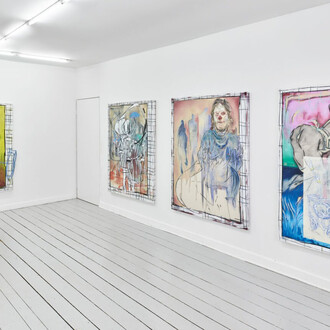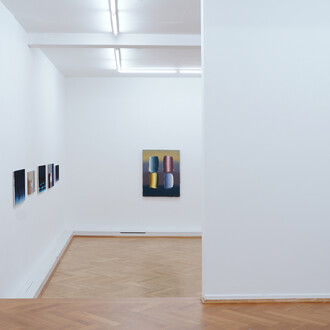Galerie Thomas Zander is delighted to announce its upcoming exhibition juxtaposing selected works by Günter Umberg and James White, and inviting a dialogue between their artistic practices. Following the exhibition Die Farbe Grau with works by Gerhard Richter and Michael Schmidt, it is the second in a series of themed two-artist exhibitions Galerie Thomas Zander is presenting this year.
Günter Umberg, born 1942 in Bonn, defines painting as “painted colour” regardless of any content whatsoever. Extensively investigating the manifestations and discourses of the medium, with a particular interest in medieval panel painting, Umberg has radically reduced the means of painting to its essentials. His work draws on traditional elements while simultaneously challenging them to reintroduce a distinct mode of attention to the image into contemporary painting. The sheer presence of colour is of fundamental importance to his work. The materiality and texture of the pigments in his paintings produce an uncanny, impalpable effect of depth. Umberg binds different kinds and mixtures of pigments with dammar resin and applies them onto the panel in numerous layers, creating a highly delicate surface that is at times densely opaque, open-pored or even slightly transparent. The physical presence of the painting comes more and more into focus, its existence as an object. The paintings are executed on rectangular and almost square wood panels of varying thickness. The panels’ bevelled sides become narrower towards the wall and often leave the edges of an orange to ochre coloured ground visible, a reference to gilded paintings from the Middle Ages. As a result, the image exposes its surface openly and unprotected. There is nothing to distract from it, which makes the works all the more challenging to view. Among other works, the exhibition presents an early vertical painting from 1976 and a selection of individual smaller paintings from Umberg’s current working period. These images embrace all colours from the subtlest hues of grey, blue and black to a bright yellow, as in the case of Plan No. 7, 2017/18. It consists of a group of six independent works oriented along the axes of two light sycamore panels, which are arranged in the shape of a cross. This intermediate layer has the industrial character of construction material, revealing an open honeycomb core open at the sides. Neither image nor wall, it reinforces the layered structure as a basic principle of Umberg’s works that builds up towards an increased awareness. Exactly positioned yet never appearing static, this group of independent images emanates a gravitational field, whose centre and periphery seem to be in a process of constantly realigning themselves. As in an earlier group of works called Territorien (territories) which Umberg has created since 2007, the title Plan has equivocal meanings. It at once implies the process-based nature of the piece, its expanse and the various layers of the work and space reinforcing each other, which the viewer experiences with elevated attention.
This is the gallery’s first exhibition featuring James White’s black and white oil paintings. The works depict everyday scenes and objects such as a half empty glass or bottle, a door left ajar, a running tap. The London based artist, born in 1967, executes these reflecting surfaces intricately in a highly contrasted palette, invoking the tradition of still life painting, yet using contemporary materials, cinematic narrative devices and images of consumer objects that anchor his practise in today’s visual culture. The sources of White’s work, painted on aluminium, wood or acrylic panels, are photographs of his immediate environment at home, in bars or hotel rooms. The paintings of these mundane moments in between seem to be evidence of encounters and events taking place just before, after or outside the frame. The structured absence in them creates a narrative space charged with suspense and ambiguity, challenging relations of temporality and space as well as roles of protagonist and observer. While the verisimilitude and psychological tension of the paintings direct the viewers’ attention away from the surface, the pairing of two disparate images within a frame in some of the artist’s work showcases the process of cropping and cutting. Their display in Perspex boxes adds yet another layer of reflective remove. White’s photographic prints of familiar interior details, too, combine black and white photo-graphs with colour flares and collages with aluminium tape, emphasising their own physical construction as objects. His most recent works on paper are unique large-scale archival pigment prints of his characteristic subjects. This time the images appear muted as they seem to float above or behind a graph paper pattern, the image plane disrupted and accentuated by lines of aluminium tape or apertures cut into the surface to reveal yellow acrylic paint. The space of narrative projection only remains as an idea, while the study of the images’ complex objecthood comes to the fore.
The exhibition is an investigation into questions of surface and depth of images, closeness and distance, presence and absence. The ostensibly disparate works of the two artists explore these tensions in many varied ways not only in dialogue with each other. They also systematically sound them out in interaction with the viewer in the exhibition space, each time anew.
















